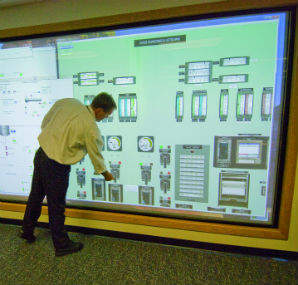The Donald C. Cook Nuclear Plant (CNP) simulation department has developed a large touch screen/classroom to support virtual simulation of control room panels as well as virtual simulation of safety related field equipment used in the chemistry training programme.


A new virtual simulator at the Donald C. Cook Nuclear Plant (CNP) includes a large auditorium classroom with seating capacity and individual touch screen computers for 30 students, primarily in operations. Each student computer is capable of running a full simulation model allowing operation of simulator systems via virtual panels. It also has a 7-foot by 17-foot rear projected display with multiple point touch screen capability for display and operation of virtual control room panels and virtually simulated field equipment. This display uses four high-resolution projectors with blended imaging creating a high quality student/instructor interface.
All control room panels can be displayed and operated just as in the full scope simulator, freeing it up for other training exercises. The classroom also has improved instruction capabilities allowing demonstration of plant/system operation in a virtual environment. It allows individually-paced student instruction for control room tasks using the individual student touch-screen computers.
American Electric Power (AEP) simulator supervisor Tim Vriezema said that the system allows trainers to be more creative in formulating the systems that are used in training: they are limited only by their imagination, he says. "You can develop anything you want to (primarily things that may be difficult to train on due to the sensitive nature of the equipment). We are currently looking into modelling of control panels for our auxiliary equipment operators for synchronization of control rod drive motor generator sets, and, for instrumentation technicians, the simulation of our solid-state reactor protection system, allowing them to practice testing and troubleshooting activities."
Vriezema gives another example. "Recently, the control room was installing a new digital feedwater heater level control system. Using the classroom display along with the individual workstation computers, each operator was able to practice use of the new system to improve his/her proficiency before plant installation."
Classroom design
The classroom was designed and built in 2011. The projection and display system is under constant improvement as new technologies become available. For the most part, the classroom design and projection was completed by in-house employees using various commercial products. GSE Systems provided all of the control room panel graphics displays. An additional six-foot 4000-pixel resolution monitor on wheels was purchased to take additional system simulations to other classrooms.
In 2012, a virtual simulation model of CNP’s Post Accident Containment Hydrogen Monitoring System (PACHMS) was developed. This simulation model includes a two-phase fluid model, logics system model, and applicable virtual panels. This virtual system, developed exclusively for training, helps perform procedure familiarization for calibration and surveillance testing for technicians. It allows them to practice in an environment more conducive to learning than the actual plant equipment, and without removal of safety-related equipment from service for training.
Development of CNP-specific virtual PACHMS equipment cost $22,000, and was carried out by CNP software engineer Nathan Chamberlin using GSE Systems’ project JDesigner; purchasing similar plant PACHMS equipment from the vendor to support chemistry technician training was quoted at eight times this. The simulation also provides additional cost benefits: little to no maintenance expenses are incurred, no equipment storage is required, and the simulation of equipment malfunctions can be created without the need to purchase additional components.
Realistic emergency planning
Integration of simulated field equipment to the plant’s real-time simulator also improves realism of emergency planning activities where field teams are dispatched to perform field tasks such as emergency system operation.
It also identified plant system design issues, Vriezema says. "When the model was complete, the chemistry technicians put the system in service and a standing control room (simulator) alarm was observed in the alarm state. After communication with the vendor, it was determined that this was in fact what the actual system would do. We were able to change the plant design for this alarm to remove a standing system abnormal alarm when in fact the system was operating correctly." Since identified, actions have been initiated to correct the design issue.
